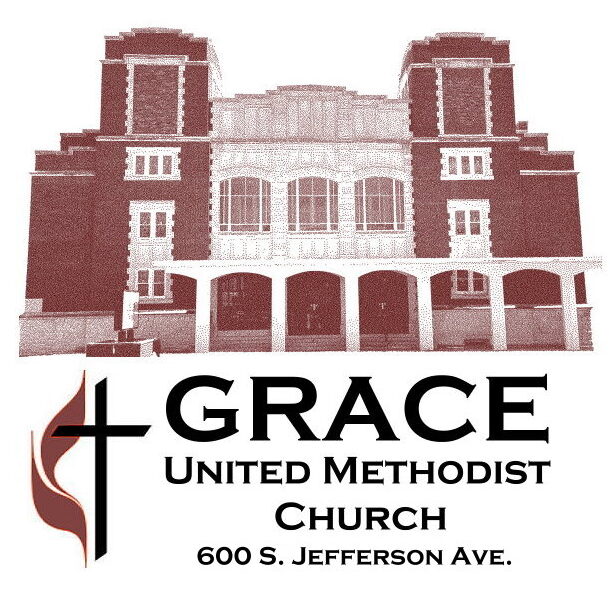The History of Grace Church
Grace Church originates in the beginnings of Springfield , Missouri. Founded in 1829, Springfield was a small hamlet buried in the Southwest Missouri Ozarks. Little existed in the way of transportation save for centuries-old roads well worn into the earth that both Native Americans and larger game used in their migratory patterns. When the settlers came early in the 19th century, the area was isolated and wild. Because of national westward expansion, in 1830, Reverend James H. Slavens was appointed by the Missouri Methodist-Episcopal Conference to Greene County to organize the Methodist Church here. At that time, Greene County was geographically 100 miles north and south, and 200 miles east and west–most of Southwest Missouri. Slavens came to Springfield, and preached the first sermon ever in the new community, on October 10, 1831, at the home of William Fulbright on what is currently the 1200 block of West College. Only nine families lived in Springfield at the time. Three weeks later, a Methodist class was organized, which met in homes on Sunday for worship, and at other times for study and prayer. Having established himself in Springfield, he soon married Louisa Amanda Rountree, daughter of settler Josiah Rountree, and commenced his work as a circuit-riding pastor through the expanse of Greene County. Travel was achieved by use of the ancient roads but streams and rivers had to be forded, or swam across.
The first church structure was built in 1833 was a one-room log cabin built on Richardson’s or Fairbank’s Spring just northeast of the city square. Today, this site is marked in Silver Springs Park on North National Avenue. William Fulbright contracted to build the little structure, which cost $18.00, and was subsequently named the Kickapoo Meeting House, so called because the church-house was built on land deeded by the U.S. government to the Kickapoo Indians. An early method of sharing space was achieved in the little church by opening the doors to the Presbyterians for Sunday afternoon services. After the Methodist congregation moved closer to town, the Presbyterians continued to occupy the building for some time.
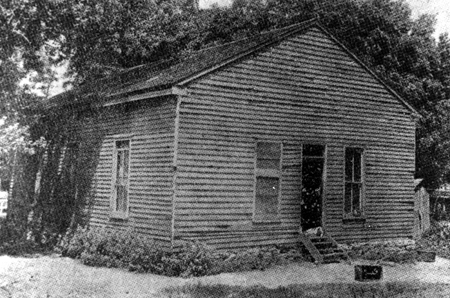
This wood frame structure, constructed in 1842, was the second home of the Methodist-Episcopal Church in Springfield , Missouri .
In 1842, after seeking a more centralized location, a wood frame structure measuring 30 x 40 feet square was constructed, on the southwest corner of present-day South Avenue and Walnut Street. Humble by present day standards, the new little structure was said to be the best church building in southwest Missouri, and was also likely one of the most advanced buildings, point-blank, in the area, with its plastered walls and rolled glass windows. At an early date in the history of the church, division began to creep in, and two factions were formed in the membership as both the church and community grew. One supported the use of the church resources as community assets and the church body as ministers in service to the somewhat unruly population of southwest Missouri. The other faction was more interested in the building of finer physical structures, the accumulation of things, and the church body as a closed social club with limited access for new membership. As a result, when Methodist-Episcopal Church split nation-wide over the issue of slavery, the Springfield Church, having already divided internally, fell into a state of some disorganization. The local church officially went with the Missouri Conference and sided with the newly formed Methodist-Episcopal Church, South. Some members withdrew while others remained with the church in a state of discontent.
No northern-sympathizing Methodist-Episcopal Church was officially formed during the following years, although some evidence suggests that an independent class was organized at some point in the 1840’s with the aid of former Pastor James Slavens. But such an effort would naturally have happened in some secrecy, and without knowledge of the Methodist-Episcopal church at large, for the majority of the church in the state supported holding slaves, and sided with the newly formed Methodist-Episcopal Church, South. Any Methodists in the state of Missouri who disagreed, especially dissenting pastors who attempted to speak against slavery and division were tortured, tarred, feathered, and run out of town on logs.
That period of chaos served as a suitable prelude to the time which followed during the Civil War in southwest Missouri. During the time leading up to the Civil War, the local Methodist-Episcopal Church, South, began the construction of a fine new building of two stories, in brick, with a soaring white spire in 1858. It was built on the same location as the former building, and the little wood church-house was moved southwest to the alley. Much larger than either previous building, the new edifice became a point of admiration throughout the region, and dominated the skyline of the growing village of Springfield. However, these were not happy times, and progress on the building was slow. By the time the Civil War began in 1861, only the ground floor meeting room was finished and ready for use. The Sanctuary above was yet to be completed.

Although construction begun in 1858, the sanctuary was not completed by the outbreak of the Civil War. Used for military purposes by both the Union and Confederacy during the war, this was the first home of the reorganized Methodist-Episcopal Church (soon to become Grace) following the war.
Known by locals of the era as “The Terrible Time,” the Civil War was just that in Springfield. After a while, no church in southwest Missouri met for worship or anything else. Says a contemporary source from Grace Church, “None of us were the same after that time. Those of us who survived were completely different than before. Children didn’t laugh – mothers wept – fathers were hollow-eyed like they had no souls. We went about our business, but we were corpses ourselves. The churches weren’t much help. Most of them were killed off – the little ones – and didn’t have much hope, faith, love, and peace to share because it was gone. Some of the people left and we never heard from them again. We didn’t know if they even made it to where they were going. Our country lost its soul during that time and nothing ever came back of it. The new one that filled the void left by the old one is mean-spirited and selfish. Nothing like the old one.” During the war, the uncompleted church building was used as an arsenal, supply depot, hospital, and stable at different times. It was cannonaded and shot, and for the rest of its useful life (until 1904) these scars could be seen.
Toward the end of the war, in 1864, Rev. L. M. Vernon was sent by the Missouri-Arkansas Conference to reorganize a Methodist-Episcopal Church in Springfield , which had by then been vacated by Confederate troops. On May 15, 1864, the church was reorganized with fifty-four members. During those first months, they likely met in the small wood frame meeting house belonging to Calvary Presbyterian Church, collecting on a decades-old debt of kindness from the Presbyterians. Soon, however, the U.S. Government granted the newly reorganized congregation the use of the big brick church house on South and Walnut and the title was purchased from the remnant of the disorganized Methodist-Episcopal Church, South. The congregation collected $1,500, and prepared the ground floor meeting room for worship. By 1865, the membership of the church doubled, and plans were made to finish the second story sanctuary. Having assumed a debt of $2,070 for the undertaking of the project, the work was completed, and the dedication scheduled when on May 28, 1868, a tornado came and caused further damage to the building, removing much of the roof and western gable.
With no financial resources, and no credit, the devastated congregation moved out of the unusable brick building, having obtained permission to meet in the U.S Courthouse on the public square. The church was sold back to the southern congregation for the amount of the unpaid debt. Twenty seven members withdrew and joined with the newly reorganized Methodist-Episcopal Church, South. With no building and no financial reserves, the congregation nevertheless began looking forward immediately, and in less than a year, a lot was purchased on South and Pershing and a plain brick building constructed. The little church was named Bentley Chapel in honor of Rev. J. J. Bentley, during whose pastorate so many obstacles had been overcome. In 1879, two brick towers were added, and the congregation adopted the name of Grace Methodist-Episcopal Church. In 1886 following a dramatic renovation of their pre-Civil War structure, the Methodist-Episcopal Church, South took the name of St. Paul .

Bentley Chapel was the fourth building of the Methodist-Episcopal Church in Springfield . Constructed in 1868, the towers were added in 1879
By the 1890’s, the little chapel was far outgrown, and a grand new brick Gothic structure was built on the front of the lot facing South Avenue. Completed in 1895, the new church building was attached to the former Bentley Chapel, which was used as a Sunday School Hall. The followed decades saw spiritual and numerical growth like no other period before or since in the local church. A newsletter, The Comet, was started to encourage the spiritual growth of all members, and the spirit of revival burned strong for years. Daily prayer meetings were held in the church and in the homes, and Grace Church grew more and more into the lighthouse her forbears prophesied she would become to the city and region.

This stone and red brick neo-Gothic structure was completed in 1895 and was located at the southeast corner of South Avenue and Pershing Street.
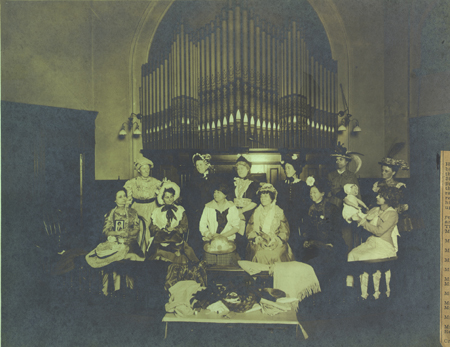
This shows the interior of the 1895 neo-Gothic church about 1910. The Estey pipe organ was purchased in 1908, and a women’s group is posed in costume behind the chancel rail.
As might be expected by such growth, the new church was soon outgrown, and by 1917, the need for larger facilities was acknowledged by the purchase of a lot on the southeast corner of Jefferson Avenue and Cherry Street. A fine new brick and Phoenix-stone building in the “Suppressed Gothic” style was constructed in two stages. The Sunday School Hall, Fellowship Hall, and Classrooms were completed in 1921, and the congregation moved to the new house of worship, meeting temporarily for religious services in the Sunday School Hall (now Hawkins Hall). While the new Sanctuary was being under construction, the former facilities were razed, and the stained glass, stone, brick, pews, organ, and other usable items salvaged and sold to help pay for the construction of the new. In 1923, the Sanctuary was completed, and the month of June was a community-wide celebration of the new structure and the role it would come to play in the community. It was then the largest church in the city, and the largest Methodist-Episcopal Church Building in the Conference.
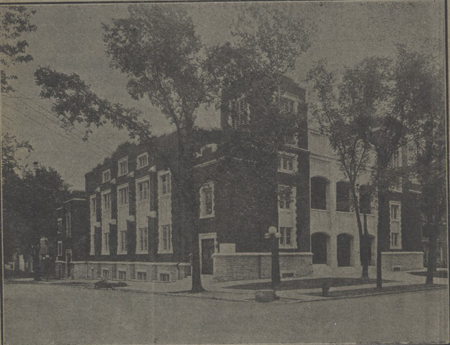
This photo shows the newly completed Grace Church in 1923 with upper and lower arcades on the west front.
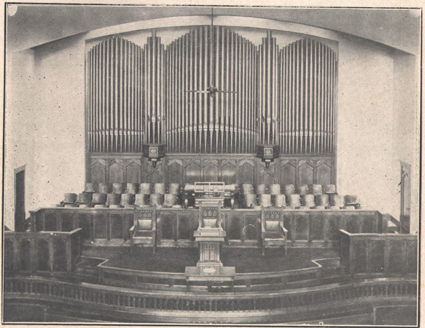
Shown here is the chancel on the interior of the Sanctuary of the 1923 building. The pulpit furniture was made to match the suppressed Gothic (featuring stylized gothic arches) architecture of the interior. The organ was new in 1923, and was made by the Reuter Organ Company of Lawrence , Kansas .
Followed by a period of continued growth, the church fell into financial hardship during the Depression-era years of the 1930’s. Unable to keep up the payments on all expenses, the church was running staff salaries in arrears, and the loan payments on the new building fell behind–with some $82,000 in debt to be paid. Foreclosure was imminent, and the congregation morose and seemingly defeated. It was on one Sunday 1936 when a common white pigeon flew in through an open office window, and landed on a framed picture of John Wesley in the church office (now the Memorial Room). The caption on the picture tells of the famous story of Wesley’s conversion in Aldersgate Street , London. And there it stayed as the congregation began to gather for worship. As the bird’s presence rippled through the church, most of the congregation filed through the office and back into the sanctuary. And the bird stayed there through all that, and through the entire morning service, on that framed photograph. The bird left sometime that afternoon, on his own accord, after everyone had gone for the day. And that day marked a turning point in the spirit of the congregation. A new financial campaign was organized, a method of debt payment worked out, and by 1937, $62,200 had been paid on the debt, and the rest provided for.

Shown here is the congregation in Sunday morning worship in April of 1958.
The church continued to flourish through the 1940’s and 50’s, with many improvements being made to the facility. Beloved pastors came and went, and many young people left from Grace Church to go into the ministry. By the early 1960’s, the pinch for growing room was again felt, this time in the Sunday School department. Every conceivable space (and many inconceivable spaces!) was being used for the Sunday School. Plans were made for a new three-story education wing designed to house all children and youth classes. Residential plots were acquired all around the church. However, there was an emerging group in the membership that pressed instead for the relocation of the church to donated land at Battlefield and Fremont Roads. And so, just days following the Centennial Celebration of 1964, the congregation was called to vote on the matter of relocation. After some discussion, it was evident that the movement to relocate was not representative of the majority of the congregation and the motion was defeated, but not without hard feelings. Many members left at that time. Shortly following was a disagreement whether to air condition the existing building, or build a smaller, two-story education wing. After further disagreement, other families left the church. As it was, the church built the adjacent education wing and air conditioned the entire plant in 1965 and 1966.
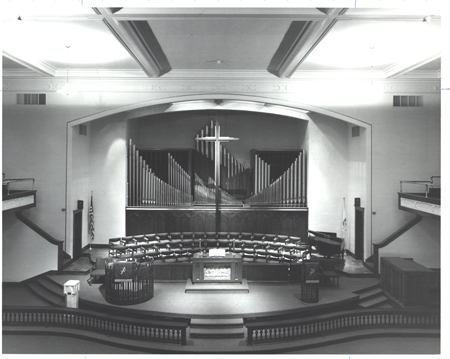
During the 1979 Sanctuary renovation, the chancel area was enlarged, new pulpit furniture construction, and a new organ commissioned from the Reuter Organ Company.
The following decades were a period of stable fellowship and continued activity, if not marked by steady and almost imperceptible decline. The programs and educational offerings increased, facilities improved and remodeled, and a new pipe organ purchased in 1979 to complete a renovation of the Sanctuary. But the congregation was aging, and many of the children raised up in the church no longer attended as adults. New families came, and some stayed, but most eventually left. Things continued in a state of gradual and steady decline until in 2005, following several failed plans of action to stabilize the remaining membership and promote new growth, the congregation voted on September 11 to merge with the nearby congregation of St. Paul United Methodist Church . Three hundred members strong, the merged church was conceived with bright hope for the future, and keen interest in a dramatically expanded membership. The new congregation chose the name of First United Methodist Church, and although the opportunities were many, the obstacles were just as numerous. Soon, many of the feelings from the period prior to the Civil War were discovered to be still in place. And not over slavery, but in general and deeply-rooted beliefs as to what the church was to be about. Central to many of the disagreements were emotional and practical feelings about the existing church structures. And so, after many failed attempts to unite the struggling congregation, the merger was dissolved with some surprise and increasing support by both former congregations in June of 2007.
On July 1, 2007, the congregation was reorganized as Grace United Methodist Church with approximately 170 names on the rolls–the third such organization in the history of the body. Having obtained a new lease on life following many years of hardship, the reorganized congregation has completed the celebration of their first year with the appointment of a new pastor, Reverend Diana Hagewood-Smith. New opportunities to serve and to share resources with the community are being realized and put into place. And the potential for the future seems ever brighter as the growing body learn again the importance of seeking first God’s Kingdom. Indeed, the hurdles of the recent past are but a bump in the road which will in time become a part of the testimony of grace working among the people of Grace United Methodist Church, in Springfield , Missouri. For many times has the church been reorganized following difficult periods, and many more times have periods of doubt, division, and misunderstanding given way to those of great faith, spiritual unity, and Christian enlightenment here in the history of Grace Church .
It is indeed as the anonymous Grace poet wrote following that earlier “terrible time:”
The flowers that bloom in spring,
Have been trampled down.
But their roots are still there
Still safe in the ground.
His Son is our Sun,
His Spirit our rain.
What He once began,
Will bloom forth again. c.1864, anonymous, from Grace Church
With every good intention for the future,
T. Daniel Hancock
History & Archives
